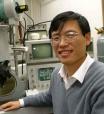
Showing 141 - 160 of 856 results
Enhancing the science of rivets earns researcher early career award
Dr Rezwanul Haque, now a senior lecturer at the University of the Sunshine Coast, received a national Young Scientist Award for his earlier research using nuclear techniques at ANSTO’s Australian Centre for Neutron Scattering to find cracks and signs of stress in riveted joints in sheet metal in car bodies.

PIXE
Particle induced X-ray emission can be used for quantitative analysis in archaeology, geology, biology, materials science and environmental pollution.
ANSTO User Meeting 2023 - Themes

Role at ANSTO

ANSTO User Meeting 2021 - Topics
Science Series Webinars
The ANSTO Science Series is a live and virtual meet-up that focuses on the key capacities of ANSTO’s people, partners and facilities and how they are meeting global challenges in sustainable industries, medicine, advanced manufacturing and in accelerating small business.
Through ANSTO, Australia is a leader in nuclear forensic science supporting global nuclear security
On behalf of Australia, ANSTO, the only nuclear reactor facility in Australia, supports the International Atomic Energy Agency (IAEA) to undertake its role in facilitating national, regional, and international efforts to enhance nuclear security, including measures to protect against nuclear terrorism.

Infrared microspectroscopy
The Infrared Microspectroscopy beamline combines the high brilliance and collimation of the synchrotron beam through a Bruker V80v Fourier Transform Infrared (FTIR) spectrometer and into a Hyperion 3000 IR microscope to reach high signal-to-noise ratios at diffraction limited spatial resolutions between 3-8 μm.
Investigating the impact of radiation and radioactive contamination on forensic trace evidence

Kookaburra - Ultra small angle neutron scattering
Ultra small angle neutron scattering on Kookaburra is used to study the size and shape of objects of size 10 micrometres and below.

Enhancing the oxidative stability of squalene

Particle Induced X-ray Emission
Particle Induced X-ray Emission (PIXE) is a powerful and relatively simple analytical technique that can be used to identify and quantify trace elements typically ranging from aluminium to to uranium.

Role at ANSTO
ANSTO's neutrons will help miners see what's inside drill cores with new clarity
The mining industry is set to benefit from a new Australian capability that uses a nuclear scanning technique to detect the presence of precious metals and strategic minerals in a core sample.

Role at ANSTO
- Leader, Energy Materials Research Project

Quantum technologies
ANSTOs capabilities are ideally suited for these investigations relating to quantum technologies.

Infrastructure - Cultural Heritage
In Australia and the Southeast Asia basin, the ANSTO facility offers a wide range of unique nuclear-beam techniques for cultural heritage research.

Role at ANSTO
New class of hydrogen conductors for industry
New class of conducting materials found for potential use in next generation fuel cells and other applications.